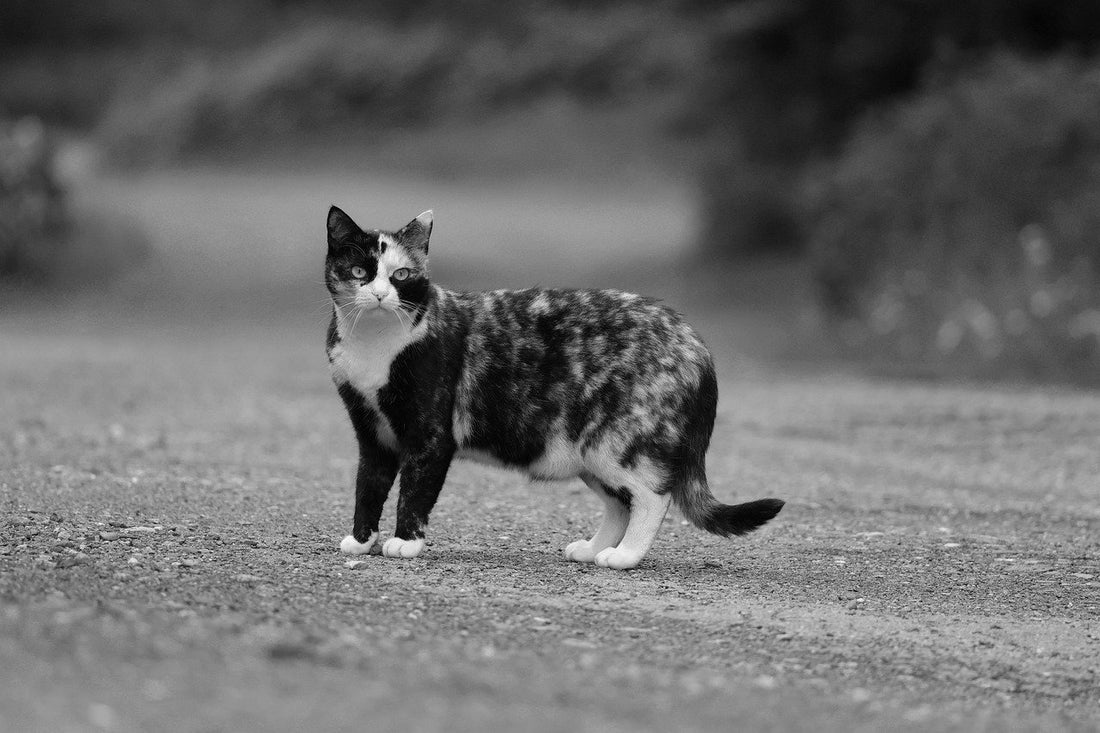

Cat fur coloration is a blend of genetics, health, and environmental factors. White fur in the dark coat can be puzzling. So why does my black cat have white hairs? Sometimes, cats have chunks of white fur. These gene-inspired patches are called a white spot, an inherited trait.
We'll explain four reasons for a black cat turning white. But remember white bald spots are normal. Also, we'll look into optimal cat grooming and health practices to remove worries in this post ahead!
Age and grey hair are two sides of the same coin.
Role of Natural Aging Process
As cats age, it is natural for their fur to change. Just like humans, cats can develop grey or white hairs as they grow old. White specks on old cats happen especially around the face, under chin, and paws.
Some breeds, like Russian Blues, tend to have grey fur. This is a part of their natural aging process and usually begins when the cat reaches middle age, around 7-10 years old.
The greying cat fur is just like that of humans. The hair follicles produce less pigment over time. This deficiency causes the appearance of white or grey hairs on the chest and other body parts. Such normal and gradual changes generally do not indicate any hair loss.
Lifestyle practices of a cat can influence its hair color.
Impact of Diet on Fur Health
A cat's diet plays a crucial role in the health of its fur. A well-balanced diet helps maintain a healthy coat. It must be rich in essential nutrients such as proteins, vitamins, and minerals. Nutrient deficiencies can lead to dull, brittle fur and may bring about white hairs.

Health Conditions Leading to White Hairs
Fur color may change due to radiation exposure. For instance, cancer treatment requires radiation exposure. Several health conditions can cause changes in fur color.
Skin conditions like dermatitis or fungal infections, hormonal imbalances, and autoimmune diseases can affect the pigmentation of a cat's fur. Stress and anxiety have a bad impact on the fur's health. Sometimes, their combination can result in white or gray hair.
Some factors of cat hair are beyond any control like the genetics of a specific cat.
Inheritance of Fur Color
Cat hair color comes from complex genetic interactions. Black fur results from dominant genes that produce a high concentration of melanin. The melanin pigment is responsible for the dark hue.
However, cats can also carry recessive genes that may lead to patches of white fur or a mix of different fur colors. Feline genetics can be a strange actor.
Recessive Genes & Alleles
The instructions in a cat’s genes will decide its inherited traits, like the cat’s appearance. Now, we will focus on a specific inherited feature related to a cat’s different hair colors.
There are many versions of the same gene called alleles. Whether or not a cat has white spotting depends on which alleles they get from their parents.
Dominant Genes Recessive Genes Resulting Fur Color

Role of Genes in White Hairs
White hairs on a black cat can be attributed to various genetic factors. Some cats are born with a few white hairs due to genetic variations in fur pigmentation. These white hairs can also emerge over time. The interplay of dominant and recessive genes influences the timing.

Surrounding elements will influence the cat’s hair color.
Stress and Its Effects on Fur
Stress can significantly affect a cat's overall health, including its fur. Cats with extreme levels of stress may develop white hairs due to hormonal changes and reduced melanin production. So ensure a calm environment for your cat. It will lessen stress-related hair changes.
Exposure to Sunlight and Fur Color Changes
Exposure to sunlight can bleach a cat's fur. Excess sunlight will cause a lighter appearance with a tanned look, called cat hair rusting.
Black fur can develop a reddish or rusty hue when exposed to the sun for prolonged periods. So white hairs may become more noticeable. Ensuring your cat has access to shaded areas can help maintain its original fur color.
Some cat breeds can have diverse fur colors. For instance, the Turkish Van has its white coat with colored markings. Also, the Bombay cat typically has a sleek black coat that may develop white hairs with age.
Genetic Predispositions
Genetic predispositions play a significant role in fur coloration. Breeds with a diverse genetic pool are more likely to exhibit mixed fur colors. The genetic background of your cat can provide insights into its fur color changes.
There are myths about white hairs on black cats.
White Fur Is Bad Luck
Some people believe it's a sign of bad luck. This belief is an old superstition, having no proof. In reality, the color of a cat's fur, including the presence of white hairs, has no impact on luck or fortune. However, white hair may be just normal genetic makeup.
Do White Hairs Indicate Illness
Do white hairs on a black cat indicate any illness? Health issues can sometimes affect fur color. But it does not always concern cat skin. Age and genetics are the primary culprits, not any underlying diseases. However, sudden or extensive changes may need a vet consultation.
Different cat breeds have varying grooming needs. Long hair breeds like Maine Coons or Persians require more frequent brushing to prevent mats and tangles.
But short-haired breeds like American Shorthairs have easy grooming routines. The best sillicone brush can maintain a healthy coat. Learn rubber vs silicone brush.

You must pay attention to massive change in hair color and consider a vet visit.
While a tuxedo cat is cute, they might occasionally indicate a health issue. If you notice sudden or dramatic changes in your cat's fur color, it is important to consult a veterinarian. Other signs to watch for include —
Regular veterinary screenings are essential for monitoring her wellbeing. So you can detect any potential issues early and treat it fast. A scheduled check-up ensures healthy fur and wholesome life.
Now we have explained 'why does my black cat have white hairs'. You understand the causes of tuxedo coat and can remove your concerns and ensure they are in the best health. In short, genetics, aging, health, nutrition, and environmental factors all decide fur coloration.
Regular veterinary check-ups, a balanced diet, and proper grooming practices are key to maintaining your cat's overall well-being. And it's important to have a quality brush to keep your cat’s fur in top condition. Lastly, groom her often to keep her looking her best!
No comments
0 comments